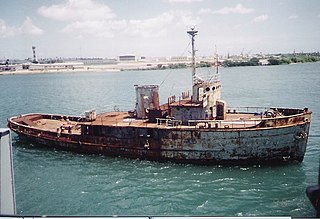
USS Abnaki (ATF-96) was the lead ship of the Abnaki class of fleet ocean tugs in the service of the United States Navy, named after the Abenaki tribe of Native Americans. She was laid down on 28 November 1942 at Charleston, South Carolina by Charleston Shipbuilding & Drydock, launched on 22 April 1943, sponsored by Mrs. James Mayon Jones, and commissioned at the Charleston Navy Yard on 25 November 1943. Abnaki earned three battle stars for service during the Korean War and 10 battle stars during the Vietnam War.
USS PC-1141 was a PC-461-class submarine chaser built for the United States Navy during World War II. She was renamed USS Pierre (PC-1141) in 1956, was decommissioned from the U.S. Navy in October 1958, and transferred to the Indonesian Navy as KRI Tjakalang.

USS Starling (AM-64) was an Auk-class minesweeper acquired by the United States Navy for the dangerous task of removing mines from minefields laid in the water to prevent ships from passing.

USS Rail (AM-26/AT-139/ATO-139) was a Lapwing-class minesweeper built for the United States Navy during World War I. She was the first U.S. Navy ship named for the rail, a small wading bird, related to the cranes.

USS Robin (AM-3) was an Lapwing-class minesweeper acquired by the U.S. Navy for the dangerous task of removing mines from minefields laid in the water to prevent ships from passing.

USS Turkey (AM-13) was a Lapwing-class minesweeper the United States Navy, thus named after the bird, not after the country which in 1917 was an enemy in the ongoing World War I. The minesweeper was acquired by for the dangerous task of removing mines from minefields laid in the water to prevent ships from passing.

The first USS Lark (AM-21) was a Lapwing-class minesweeper in the United States Navy. She was named for the lark.

USS Brant was a YMS-1-class minesweeper built for the United States Navy during World War II.

USS Seagull (AM-30) was an Lapwing-class minesweeper acquired by the United States Navy for the dangerous task of removing mines from minefields laid in the water to prevent ships from passing.

The second USS Tern (AM-31) was an Lapwing-class minesweeper acquired by the U.S. Navy for the dangerous task of removing mines from minefields laid in the water to prevent ships from passing.

The first USS Swan (AM-34/AVP-7) was a Lapwing-class minesweeper acquired by the United States Navy.

USS Grebe (AM-43) was a Lapwing-class minesweeper in the United States Navy.
USS Annoy (AM-84) was an Adroit-class minesweeper of the United States Navy. She was laid down on 3 December 1941 at Portland, Oregon, by the Commercial Iron Works; launched on 6 April 1942; and commissioned on 2 September 1942. In 1944 she was reclassified as a patrol craft and renamed PC-1588.

USS Tawasa (AT-92) was a Cherokee-class fleet tug constructed for the United States Navy during World War II. Her purpose was to aid ships, usually by towing, on the high seas or in combat or post-combat areas, plus "other duties as assigned." She served in the Pacific Ocean and had a very successful career marked by the winning of three battle stars during World War II, two during the Korean War, and seven campaign stars during the Vietnam War.

USS Tunica (ATA-178) was a Sotoyomo-class auxiliary fleet tug acquired by the United States Navy for service during and after World War II.
USS Clamp (ARS-33) was a Diver-class rescue and salvage ship acquired by the U.S. Navy during World War II. Her task was to come to the aid of stricken vessels.
USS Wateree (ATA-174), the third ship named USS Wateree, was a Sotoyomo-class auxiliary fleet tug in the service of the United States Navy during World War II. She later served with the Military Sea Transportation Service and the Peruvian Navy as a diving support ship. In Peruvian naval service she was renamed BAP Unanue (ATA-136).

The third USS Ontario (AT–13), a single screw seagoing tug, was laid down by the New York Shipbuilding Company, Camden, New Jersey on 23 November 1911, launched on 11 April 1912, and commissioned at Philadelphia Navy Yard on 4 September 1912.
The first USS Keosanqua (AT-38) was launched 26 February 1920 by Staten Island Shipbuilding Company, Port Richmond, New York; and commissioned 9 December 1920 at New York Navy Yard.
USS Arapaho (AT-68/ATF-68) was a Navajo-class fleet ocean tug which served the U.S. Navy during World War II with her towing services. She was assigned initially to support the U.S. Atlantic Fleet, and was eventually assigned to support Allied forces in the war zones of the Pacific Ocean, resulting in her crew returning home after the war with four battle stars to their credit.














